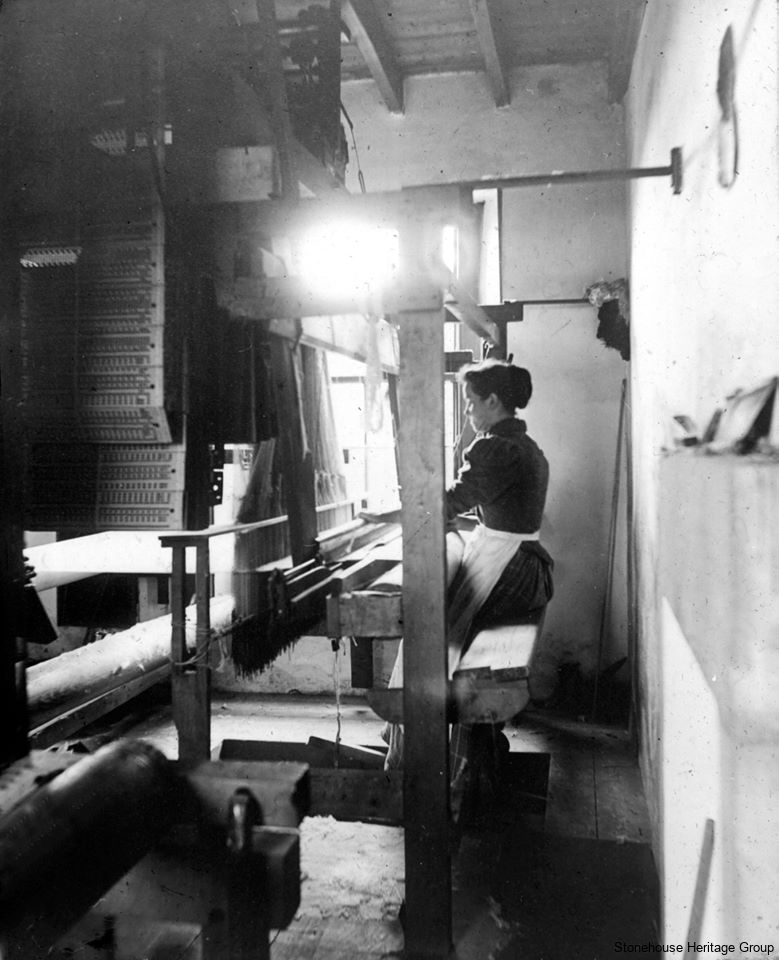Scottish hand weaving during the period 1795-1850 experienced great swings in the variety of fabric worked with linen being the dominant material prior to 1790. This moved to cotton until the mid 19th century. The innovations of inventors like Hargreaves, Cartwright, Crompton and Kay revolutionised the weaving industry in the late 1700’s. The invention of the Jacquard handloom at the latter end of the 19th century enabled weavers to produce fine intricate patterns at faster speeds.
Hand loom weaving was a family business, the trade being handed down from father to son. There was also a great dependency on women in the weaving process, undertaking such tasks as pin winding, tambouring and embroidery.
Stonehouse weavers obtained their materials from agents in the village, as well as from Strathaven and Larkhall returning the finished cloth after several weeks. These agents included Thomas Frew of Queen Street, Strathaven, Caldwell and Young of King Street and Robert Miller of Camnethan Street.
It was the industrialisation and creation of factories that brought about the demise of the weaving industry, however the Stonehouse weavers were able to adapt better than most, establishing a reputation in the craft of silk hand weaving, employing 531 inhabitants in 1861. Working closely with Strathaven, the Stonehouse weavers produced silk scarves, handkerchiefs and assorted exports for the Indian, as well as the home market. The demand for silk material declined after the first world war.
As power loom weaving increased, the hand loom weavers could not compete with the prices of cotton, woollen and linen materials due to the materials being bought in larger quantities.
Up until 1820-1830 handloom weaving was the highest paid employment of the ordinary working classes but as pay rates declined and work became scarce towards the end of the 19th century, the weavers turned to agriculture and the mines to supplement their income.
In the second half of the 19th century there were still weavers working in Hamilton, Larkhall, Stonehouse and Strathaven. Local historian John Young has intimated that the last two weavers from Lanarkshire, were Robert and James Hamilton of Camnethan Street. James died at the age of 84 in 1959 and completed his last ‘wab’ in 1939. The silk loom belonging to the Hamilton Brothers now rests in the Royal Scottish Museum, Edinburgh.
In Statistical Account by Rev Robert Pollock 1953 he states that there were still working looms in the village but that they were principally museum pieces. The annual medical report of Stonehouse Hospital in 1903 states there were still 35 weaving shops in working order in the village.
When weaving was at its peak in the early 1800’s, the weavers were prosperous enough to own their own property. Streets of privately owned cottages were built, such as those in Hill Road and Camnethan Street. The houses were generally, though not always, one storey terraced houses with the front door opening to the street. This door led to a stone-flagged entry which gave access to the weaving shop on one side and to the living quarters of one or two rooms to the other. A ladder from the entry to the loft gave storage and extra sleeping space. A washhouse was usually added at the rear of the building. The weaving shop would hold from one to six looms which were worked by the weaver and his family. The first of these houses cost approximately £45 – £60, with the repayments being only a little more than the cost of rent. The introduction of building societies around 1830 led to progressive new building developments and with the establishment of two friendly societies in the mid 19th century a sickness relief fund was set up for weavers. Many of these cottages have now been restored, retaining their character and fine sandstone appearance.
Originally all these cottages were thatched. During the hot summers, the thatched roofs were prone to fires, which could often spread to adjoining cottages. In 1857 the nearest fire service was in Hamilton. In the event of a fire, the people would be alerted by a bell in the old jail house. Fires were quite common in the eighteenth and nineteenth centuries, so the people were extremely organised forming chains of buckets from the nearest well. In 1857 the Black Bull was burned to the ground despite the valiant efforts of the crowd. To prevent birds nesting, a fine mesh was laid over the thatch. The last thatched cottage in the village was around the mid-nineteen sixties.
Weaving at 16 Camnethan Street
The following account by Sheena Cooper provides an overview of the weaving shop at 16 Camnethan Street.
Weaving slides
The following slide show provides an indication of weaving in the village.

